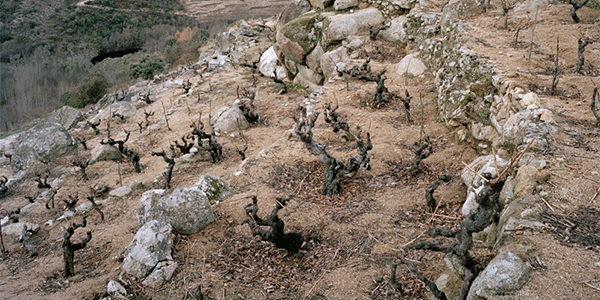Spanish wine into the 21st century

In the early 21st century, wine in Spain expresses a dazzling array of stylistic, regional, varietal and ideological variants, inflected variously in castellano, galego, catalan, euskadi and jerezano. Heritage, autochthonous, organic and artisan viticultural projects jostle with industrial-capitalist juggernauts, commercial me-tooism, French stuff and clonal nursery genetics for their share of room within the 'Spanish Wine' rubric. It will be fascinating to see where this all goes in coming years. But before we get into that, it's important to understand how 'now' came about.
Spain's Difficult 20th Century
We have all grown up drinking wine in the 20th century, and for most of us all the great wines of history have come from this time. And yet, there's a sense in which this must have been a down season for Wine: the first part of the era was spent recovering from a major blight, and in the second half we learnt to kill Wine's soil with chemicals, cross-dress Her in flamboyant technology, and facelift Her with pouty lips thanks for further chemical injection.
In Spain, She had an even tougher time thanks to war, demagogery, and mass poverty. For much of the 20th century, Wine in Spain had her best tendencies and possibilities utterly abandoned.
100, and 20 (or, what are these vines and how to work with them?)
Nowadays, when one reads about Spain’s best producers of regionally-specific wines, it’s extremely common to read that: “they nurture small parcels of historical genetics around 100 years old, with most plantings being mature(ing) vines 20-30 years old. These were selected, grafted, re-planted from the heritage gear.” I have written more-or-less identical versions of this story about dozens of specialist, focused producers. It is, simply, the story of Vitis vinifera in Spain during the 20th century.
During the 20th century, Spain’s most interesting varieties were largely displaced, so much so that during the recovery phase since 1982, they have had to be re-discovered, re-planted, re-learned: “what is this thing, how do I plant, grow, manage, nurture and interpret it?”
Phylloxera, Recovery
Prior to phylloxera, Spain had a detailed web of locally adapted cultivars. We have no idea what originary strands of vitis vinifera there were, but we know when they came (firstly with the Phonecians nearly 3,000 years ago and later with the Romans). Especially due to Roman miscegeny, vitis vinifera was scattered across Spain, came to earth, settled and adapted in situ. It became the Callet native to Mallorca, the Monastrell of Alicante, Rioja’s Tempranillo and the sibling Tinto Fino of Ribera del Duero. Galicia turned vitis vinifera into Mencia and its field-blended friends (Merenzao, Brancellao and co). Monastrell further migrated to become Mourvedre in France, and so on.
Everywhere, the not-so-silent watchmaker in this adaptive genesis were the farmers. Each year, they made countless little decisions: “I have 30 vines to re-plant, where individuals have died, or at least not done well. I like this one for its flavour and this one for its yield; this one suits the windy side of the slope best, and this one has always been particularly hardy against pests.”
30 selections, 30 grafts, 30 minute evolutionary decisions. Multiply and multiply across all the fields and over all the years, and vitis vinifera underwent multiple managed, selective evolutions to became regionally-specific varieties. The local varieties which evolved were conditioned responses to the land and weather of each place, and both hardy and productive in those places. And in each place, they reflected the human palate: Mencia, in Bierzo, in one respect is exactly the same as Callet, in Pla i Levant, or for that matter, Nebbiolo, in Barolo (and all the others). Although their flavours, the nature of their skins, and their quantity, ratio and balance of acid and tannin are all different, each regionally-evolved variety equally express the human preference for intertwined sweet-and-sour, for fruit-with-structure. All the same, yet very different, and each configured both by place and by people.
By the late 19th century, Spain had a plethora of beautifully adapted local cultivars. In the main, these were in remote locations and farmed by people living pueblo lives. There was little if any migration, of people or of vitis vinifera genetics from one place to another. Each regional variety had a long history of farming, with vineyard siting, pruning and other facets of viticulture and harvesting time-tested. Then came phylloxera, from about 1892 … some regions were not hit by phylloxera until 1901 or 1902. With the American rootstock solution already readily available, in Spain the devastation was relatively short-lived. Within a decade or so, re-planting was well under way. Most re-planting was done by the same farmers who were managing the fields when phylloxera struck. In the main, vineyards were re-established with selections from surviving examples of the locally-adapted cultivars which had previously populated them. The genetic heritage, viticultural practises and lore of each place was resumed, unbreached.
By the start of the Civil War in the mid-1930s, a large proportion of Spain’s historical wine grape identity had been successfully re-established.
Civil War, Abandonment
Civil War. Not so civil. By 1940, Spain was riven, and becoming desperately poor. In particular, pueblo-life in the countryside was terribly afflicted. It’s not that there was not enough (money, food, economic activity), so much as there was no economy. And that which existed was taxed mercilessly by Madrid. The possibility of estate-growing, of farming for quality and profit, did not exist (but for The Riojan Exception ). In particular, there was nothing for youth: to grow up young in farming regions necessitated leaving. City work, army, mines … leave for what you can find, there’s nothing for you here. The pueblos became demographic deserts.
Almost all viticulture devolved to growing for local co-operatives, and volume was the only denominator. Viticulture went, quite literally, downhill: where the best local varieties had always been grown in poor soils on hill-slopes, now vines were re-planted in the fertile soils of the valley floor. Qualitative considerations bent the knee to the quantitative. The best quality local varieties most often were not the most productive, so out they went.
Different versions of the same story abound:
• In Galicia, the local Godello, Mencia, Treixadura all become valley floor ‘Jerez’ - Palomino grapes the size of one’s head grown in rich soils became the entirety of Galician viticulture.
• In Priorat, Garnatxa gave way to the more productive Caranyena.
• In Ribera del Duero, red wine became field-blend Clarete. Culture, lore, place and variety were all abandoned. The people had to abandon the countryside, and the countryside abandoned its best viticultural ways. Almost all was lost.
Democracy, Rediscovery
Franco died in 1975. Partial democracy was re-introduced (along with a panic-now constitution) in 1977 and full democratic practise (in a Spanish flavour) resumed in 1982. Spain opened up, literally, fiscally and emotionally. With flows of people and money (thanks, EU) came flows of ideas. With open minds and fiscal possibility came the re-discovery:
“Why am I growing high crop Palomino in the valley floor, when my grandfather used to grow wonderful local varieties up in the hill crags?”
And,
“Well, look, some of grandfather’s vines are still there, eking out little crops of historical house wine grown by the poblanos!”
So,
“What if I buy the old vines which have somehow continued, and use their genetic heritage to plant anew, in the old places and in the time-hewn manner?”
This led to much “what is this vine - Mencia, Merenzao, or some other thing entirely?”, and equally to lots of “where and how to best grow this-or-that?”
Many DOs were established in the 1980s, helping underscore and organise the rediscovery and re-establishment of historically local viticulture. Nowadays, many tiny 100 year-old plots of post-phylloxera heritage vineyards have been recovered; these have since parented many more plots of local genetics which are now matur(ing) at 20 and 30 years old. Spain’s viticultural heritage is slowly being rediscovered, re-planted and re-interpreted.
There is, of course, also a frightening concentration of generic or exogenous plantings (Tempranillo everywhere, and Frenchies too), stuff on trellises, stuff from the nurseries, dead soils farmed with chemicals, and an Australian-scale cohort of chemically-affected “mommy’s got two heads” wines. But that is the story of everywhere, and what becomes of these is the 21st century’s story to tell. Fortunately, strands of that story can also be told with the voice of the 100-and-something years old viticultural heritage of Spain’s vineyards, echoed by the increasingly resonant 20-somethings to whom they pass their genetic legacy.
In the early 21st century, Spanish viticulture is finally in an open field, post-abandonment.
Scott Wasley